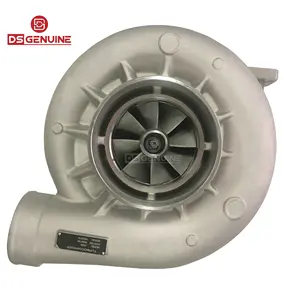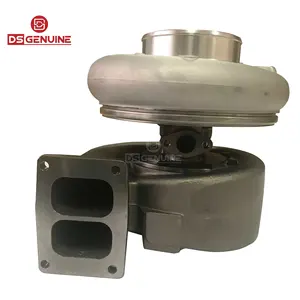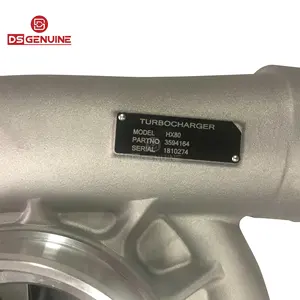(464 products available)



















































































































































Generally, the HX80 is a larger turbocharger compared to the HX60 series. It's designed for heavy-duty applications, such as trucks and buses. The HX80 turbocharger is commonly used to improve the performance of larger diesel engines, particularly in commercial vehicles. By forcing more air into the combustion chamber, the HX80 turbocharger allows for more fuel to be burned, resulting in increased power output. This is especially beneficial for heavy vehicles that require more torque and power to move efficiently.
HX801
HX801 turbochargers are designed for high-performance engines in sports cars and racing vehicles. These turbochargers help boost the power output of the engine, giving it a significant performance advantage. The increased power output enables the vehicle to accelerate faster and reach higher speeds. For instance, a sports car with an HX801 turbocharger can go from 0 to 100 km/h in a shorter time, giving it a competitive edge on the racetrack. Additionally, the turbochargers improve the overall efficiency of the engine. The forced induction increases the intake air density, allowing for more precise control of the air-fuel mixture. This results in better combustion and improved thermal efficiency. The HX801 turbocharger also aids in engine cooling by using a larger intercooler.
HX802
The HX802 is a variable geometry turbocharger (VGT) that offers several advantages over conventional fixed geometry turbochargers. Firstly, the HX802 VGT turbocharger improves low-end torque and throttle response. This is particularly useful for applications such as towing or hauling heavy loads. The adjustable guide vanes in the turbine allow for optimal matching of the exhaust flow to the boost pressure, resulting in better low-end performance.
HX803
The HX803 turbocharger is designed with advanced materials and manufacturing processes to enhance durability and reliability. For example, the turbine wheel and compressor wheel in the HX803 turbocharger are often made from high-strength aluminum or titanium alloys. These materials can withstand higher temperatures and pressures, making the turbocharger suitable for demanding applications.
Regular Oil Changes
Turbochargers need clean oil regularly. Change the oil per the car manufacturer's guide. This removes debris and keeps the turbo well-lubricated.
Quality Fuel
Use high-quality fuel with the right octane rating for the turbo engine. Avoid fuel with low quality or inadequate octane, which can damage the turbo over time.
Cool Down
Always idle the engine for a few minutes before shutting it off, mainly after hard driving. This allows the turbo to cool and prevents hot oil from coking on the turbo.
Inspect Hoses and Connections
Check all hoses, clamps, and connections for leaks or wear periodically. Replacing worn parts maintains proper boost pressure and prevents turbo damage.
Clean Air Filter
Air filters should be cleaned or replaced regularly to ensure proper airflow. A clean air filter helps the turbo get the air it needs to perform optimally.
Check Wastegate Operation
Ensure the wastegate valve on the turbo functions correctly. A faulty wastegate can lead to overboosting or underboosting, affecting turbo performance.
Monitor Boost Pressure
Use a boost gauge to ensure the turbo generates the correct boost levels. Too high or too low boost can strain the engine and the turbocharger itself.
Inspect Heat Shielding
Periodically, check the heat shields around the turbo. They protect other engine parts from heat. Damaged shields can lead to overheating issues.
Professional Turbo Inspection
A mechanic should inspect the turbo for signs of wear or damage. Catching problems early can save on expensive repairs later. The mechanic can also do other needed maintenance.
Wholesale buyers need to understand the factors that affect the suitability of the HX80 turbo for various applications. Here are the key considerations:
Engine Size and Type
The turbocharger should be compatible with the engine in terms of its size and type. Larger turbochargers, like the HX80, are better suited for larger engines. Additionally, consider the fuel type used in the engine. Gasoline and diesel engines have different characteristics that affect turbocharger selection.
Performance Goals
Consider what level of performance is desired from the turbocharged engine. If quick response and low-end torque are important, a smaller turbocharger with an internal wastegate may be better. For maximum power output, a larger turbocharger with a twin-scroll or external wastegate design would be more appropriate.
Vehicle Usage
The intended use of the vehicle should influence turbocharger choice as well. For daily driving with occasional performance needs, a balanced turbocharger provides versatility. If primarily track or race use is planned, a turbocharger optimized for those conditions will yield better results.
Budget
Of course, cost must also be factored into the equation. Larger, more complex turbochargers tend to come with a higher price tag. In addition to the initial purchase cost, consider installation difficulty and any required supporting modifications or components when determining overall value.
Replacing a turbocharger is no simple task. To ensure the turbocharger is replaced correctly, the turbo replacement guide should be followed. Before starting the installation process, ensure that the new HX80 turbocharger is compatible with the vehicle's engine.
It is important to work on a well-lit and ventilated area. Gather all the necessary tools needed for the project. Some of the tools that will be needed include a socket set, ratchet, torque wrench, and a new gasket set. It's also a good idea to have a repair manual for the specific vehicle on hand, as it will provide detailed instructions and torque specifications.
For safety purposes, disconnect the vehicle's battery before beginning the installation. Disconnect the old turbocharger from the vehicle by removing the downpipe, oil feed line, oil return line, cooling lines, air inlet pipe, and outlet pipe. Once the old turbo has been removed, the new turbo can be mounted onto the manifold using new gaskets. After that, reconnect all the lines and pipes that were disconnected in step 5. Reconnect the battery and start the vehicle to ensure that the turbo is working properly.
Doing a turbo replacement can be difficult if one has no prior experience. If the turbo replacement is done correctly, the vehicle should have improved acceleration, better fuel efficiency, and increased power.
Q1: What are the common symptoms of a failing HX80 turbocharger?
A1: Hx80 turbocharger issues can be identified in several ways. The most noticeable sign is excessive exhaust smoke. A reduction in power, especially at high speeds, is another symptom. Users may also notice abnormal noises, such as a hissing sound, when the turbo is failing. Other signs include an illuminated check engine light and increased fuel consumption.
Q2: How long does an HX80 turbocharger last?
A2: Turbochargers are designed to last as long as the engine. However, factors such as poor maintenance, oil contamination, and manufacturing defects can shorten their lifespan. Generally, an HX80 turbocharger can last between 100,000 to 200,000 miles with proper maintenance.
Q3: Can a turbocharger be repaired?
A3: Yes, Turbochargers can be repaired. However, replacing the turbocharger is more cost-effective in the long run. A new turbo comes with a warranty, which is not the case with a repaired one. Furthermore, repairs may not restore the turbo to its original condition.
Q4: Can users drive with a faulty turbocharger?
A4: Driving with a faulty turbo is not advisable. A faulty turbo can cause further damage to the engine, increase emissions, and reduce drivability. The problem should be fixed as soon as possible to avoid incurring more repair costs.
Q5: What should users do if their turbocharger warranty has expired?
A5: If the turbocharger warranty has expired, users should have it serviced by an authorized dealer. The dealer will use original replacement parts, maintaining the integrity of the turbo. Users should keep the service receipts in case they need to prove the maintenance history.